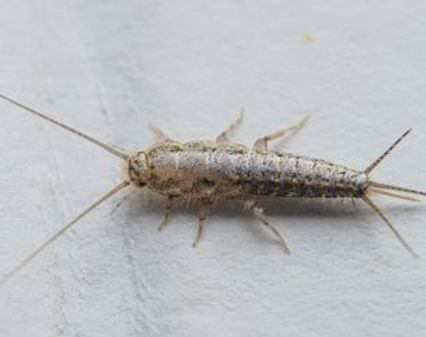
Behavior
Silverfish are small, wingless insects belonging to the order Thysanura. They are nocturnal creatures and prefer dark, damp environments. Here are some key behaviors and characteristics of silverfish:
- Habitat Preferences: Silverfish prefer to live in areas with high humidity and moisture, such as bathrooms, kitchens, basements, and attics. They are often found hiding in cracks, crevices, and other tight spaces.
- Nocturnal Activity: Silverfish are primarily active during the night, seeking out food sources and mating partners under the cover of darkness.
- Scavengers: Silverfish are scavengers and are known to feed on a variety of materials, including carbohydrates, sugars, starches, and proteins. They can damage items such as books, paper, fabrics, wallpaper, and cardboard.
- Long Lifespan: Silverfish have a relatively long lifespan for insects, typically ranging from two to eight years.
- Quick and Agile: They are fast-moving and agile insects, able to dart quickly away from threats or disturbances.
- Nocturnal Foraging: Silverfish prefer to forage at night when it’s darker and safer for them. They use their antennae to detect food sources and other environmental cues.
- Photophobic: Silverfish are photophobic, meaning they are sensitive to light. They will often scurry away to darker areas when exposed to light.
- Silent Insects: Silverfish do not make any noticeable sounds or noises, making them difficult to detect without visual confirmation.
- Egg-Laying: Female silverfish lay small, white, oval-shaped eggs in cracks and crevices. These eggs hatch into nymphs, which resemble smaller versions of adults.
- Molting: Silverfish undergo a gradual metamorphosis, shedding their exoskeletons (molting) throughout their life. Molting allows them to grow and develop.
- Survival Adaptations: Silverfish can survive for long periods without food and can endure extreme conditions, such as starvation and desiccation (drying out).
While silverfish are generally considered nuisance pests due to their scavenging behavior and potential to damage certain items, they do not pose any direct threat to humans or pets. However, their presence can be indicative of underlying moisture issues in the home, which could lead to mold and other problems. Effective pest management and moisture control can help prevent and manage silverfish infestations.
Infestation Warning Signs
Signs of a silverfish infestation in your home may include the following:
- Silverfish Sightings: The most obvious sign is actually seeing silverfish in your living spaces, especially during the nighttime when they are most active. They have a distinct, silvery appearance and move quickly.
- Shed Skin: Silverfish undergo molting as they grow. You may find their shed exoskeletons around infested areas. These discarded skins resemble tiny, translucent replicas of the silverfish.
- Damage to Paper and Fabrics: Silverfish are known to feed on various materials, including paper, books, fabrics, and wallpaper. Look for small irregular holes or chewed edges on paper items or clothing.
- Yellow Stains: As silverfish consume materials high in carbohydrates, they excrete waste with a yellowish appearance. You may notice these stains on surfaces like paper or fabric.
- Scales and Feces: Silverfish produce small, pepper-like feces that can be found near their hiding places or in areas where they feed. These feces may resemble tiny black or brown specks.
- Preferred Hiding Places: Silverfish prefer dark, damp areas. Check for signs of infestation in places like bathrooms, kitchens, basements, attics, and storage rooms.
- Damage to Books and Photos: Silverfish may damage old books, photographs, and other paper-based items, leaving behind chewed edges and holes.
- Starchy Food Packaging Damage: They are attracted to starchy or sugary foods. Check for damage to food packaging, especially cardboard boxes.
- Musty Odor: A strong musty or unpleasant odor can be a sign of a severe silverfish infestation, as they release pheromones that can accumulate over time.
- Egg Casings: Female silverfish lay small white eggs in cracks and crevices. These eggs are often found near their hiding spots.
If you notice any of these signs, it’s essential to address the silverfish infestation promptly. Taking action can help prevent further damage to your belongings and reduce the population of silverfish in your home. Implementing good hygiene practices and reducing moisture levels can also help in preventing future infestations. If the infestation is extensive or persistent, consider contacting a professional pest control service to effectively manage the problem.
Top Pest Control Tips
Getting rid of silverfish requires a combination of preventive measures and targeted treatments. Here are the top tips to help you eliminate silverfish from your home:
- Reduce Moisture: Silverfish thrive in humid environments, so the first step is to address any moisture issues in your home. Use dehumidifiers in damp areas, fix leaks promptly, ensure proper ventilation, and avoid excess humidity.
- Seal Entry Points: Prevent silverfish from entering your home by sealing cracks, gaps, and openings around doors, windows, and utility lines. This will create a barrier and limit their access.
- Remove Food Sources: Silverfish feed on starchy and sugary items, such as paper, books, and fabrics. Store important documents, books, and clothing in sealed containers to limit their food sources.
- Declutter and Organize: Keep your living spaces tidy and clutter-free. Removing unnecessary items will reduce potential hiding spots for silverfish.
- Vacuum Regularly: Regular vacuuming can help remove silverfish, their eggs, and food particles from your floors and carpets. Be sure to empty the vacuum bag or canister outside to prevent re-infestation.
- Use Natural Repellents: Certain natural substances act as repellents to silverfish. You can try using essential oils like cedar, lavender, or citrus as deterrents in infested areas.
- Diatomaceous Earth: Sprinkling diatomaceous earth in areas where silverfish are present can help dehydrate and kill them. Be sure to use food-grade diatomaceous earth and follow safety precautions.
- Boric Acid: Boric acid is an effective insecticide for silverfish. Apply it in areas where silverfish frequent but be cautious if you have pets or small children, as boric acid can be toxic if ingested.
- Sticky Traps: Place sticky traps near areas with silverfish activity to catch and monitor their presence.
- Professional Pest Control: If your silverfish infestation is severe or persistent, consider hiring a professional pest control service. They can provide targeted treatments and expert advice to eliminate the problem effectively.
Remember that silverfish can be resilient pests, and it may take time and consistent efforts to completely eliminate them from your home. Combining preventive measures with appropriate treatment options will increase your chances of success in getting rid of silverfish and preventing future infestations.

